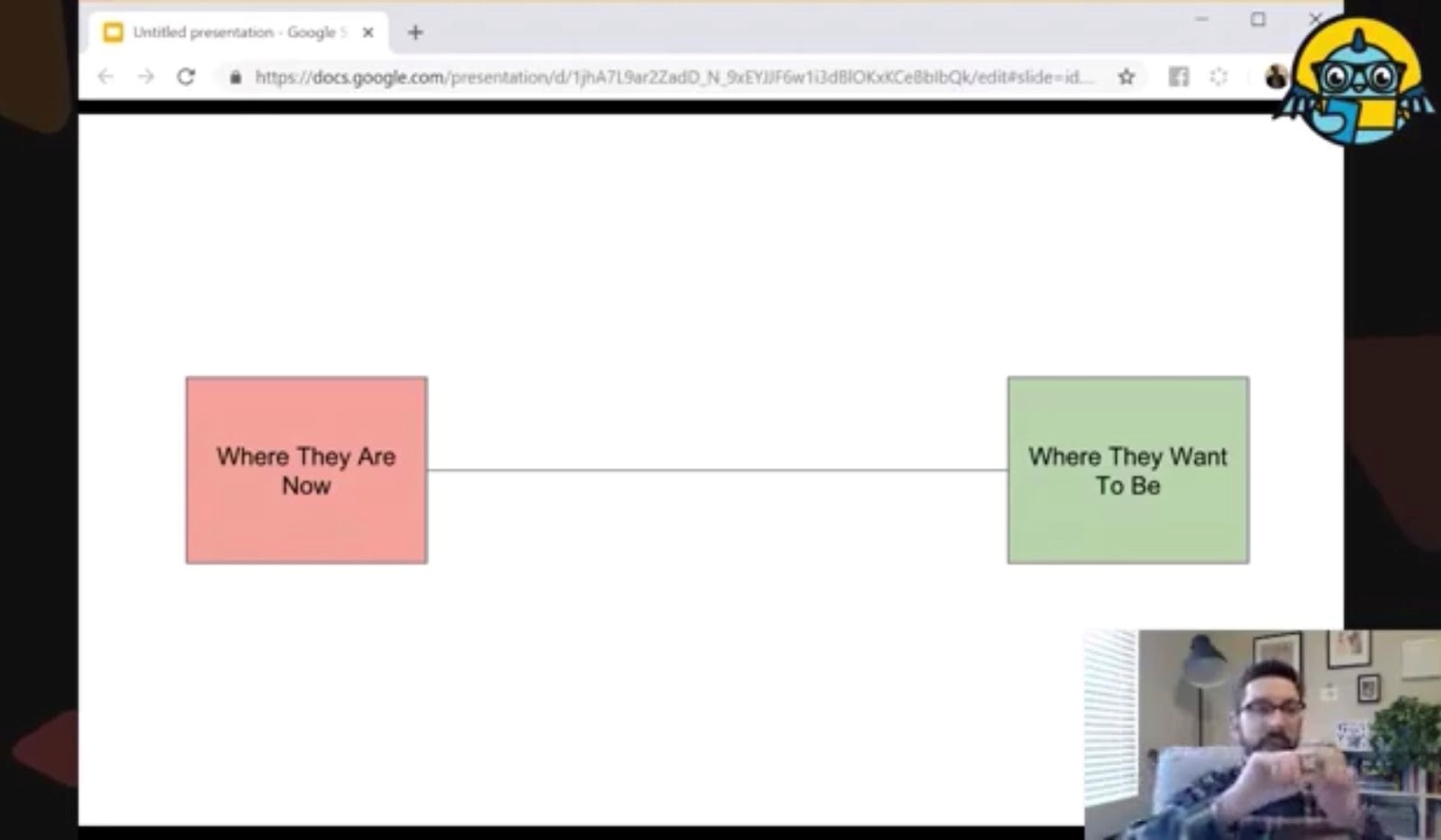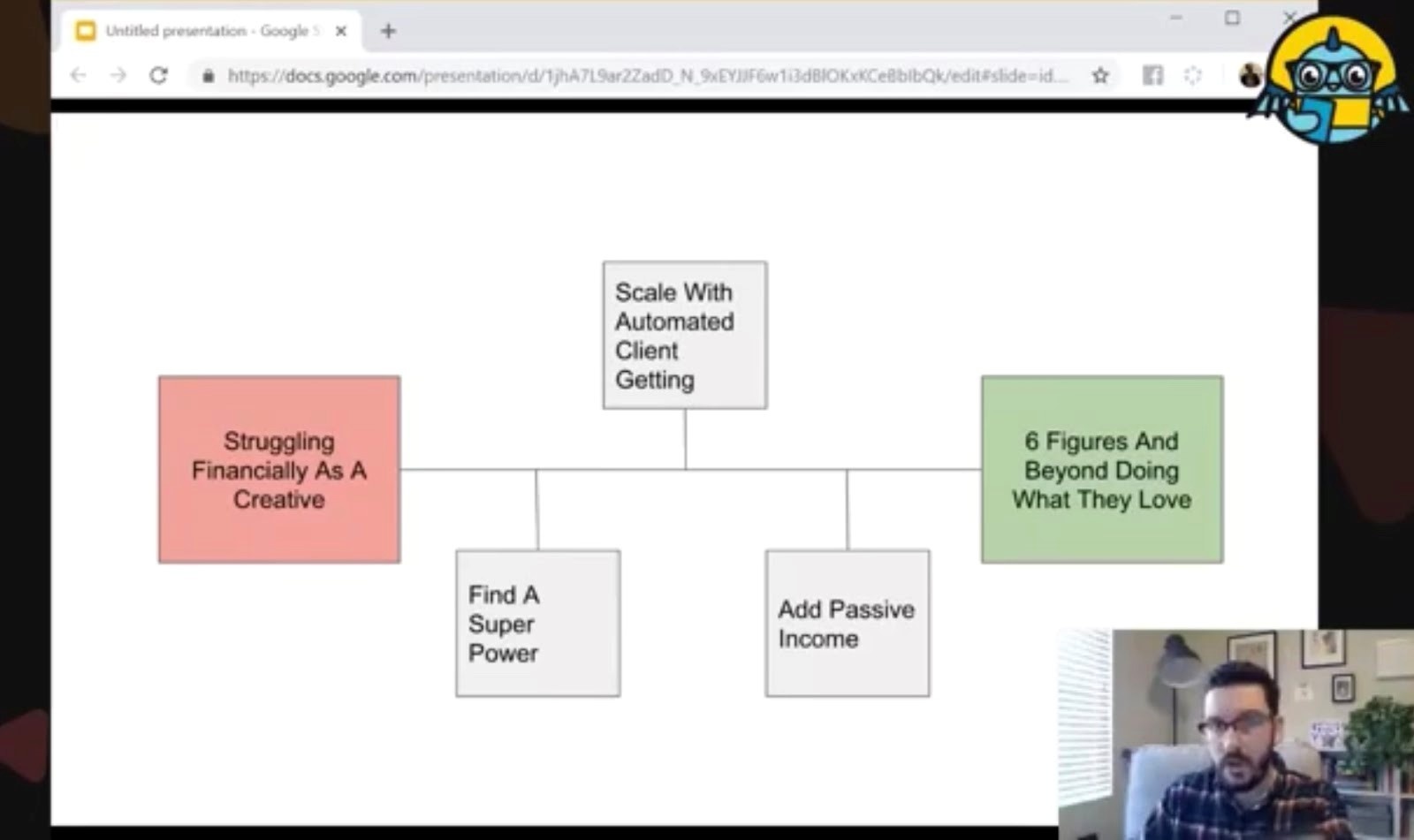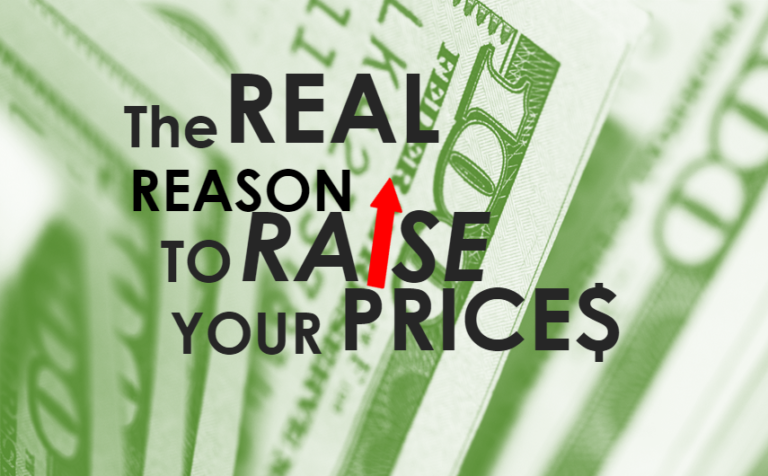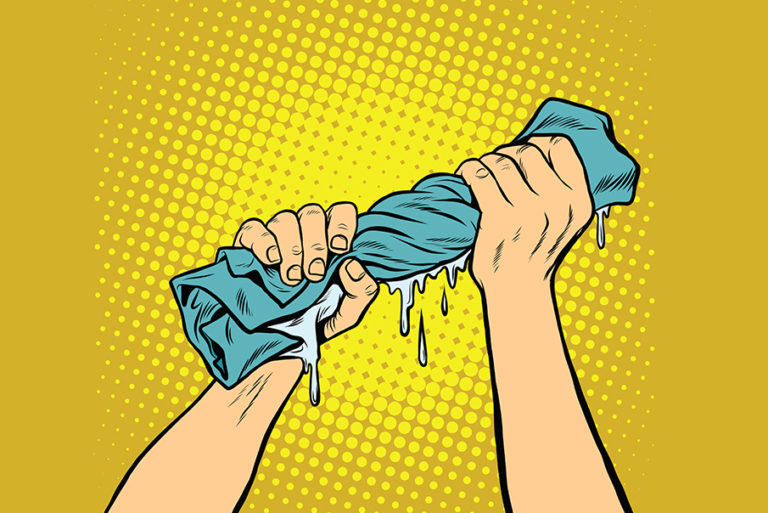Turning strangers into clients?
Is that really what you got yourself into when you decided to take on this whole freelancing thing?
Sure, you love creating your own work schedule, and spending more time with your family.
The lack of commute is really nice.
You don’t miss having a boss breathing down your neck.
And being able to make as much money as you want is a definite perk.
Still… finding great clients who value the work you do seems like such a struggle sometimes!
Constantly selling yourself to strangers is not only awkward, it can feel kind of gross.
But what if there was a way to find genuine humans who want to pay top dollar for your help?
What if you could do that while still maintaining your integrity?
That’s the reality of this 2 step method taught by Mike Shreeve in The No Pants Project.
You can apply this strategy, at any time, to help you find phenomenal clients that you enjoy working with.
In fact, you don’t even have to spend your working hours constantly hunting these dream clients down.
In this video Mike shared earlier this year, he teaches how to attract your ideal audience to you (without tricks), and what to say to turn those strangers into clients in two easy steps.
Here’s how:
1) Pinpoint Your Client’s Burning Desire
If you want to attract the right people to your services, you first need to take the time to identify the type of client that is right for you.
In business, this identification process is sometimes called “finding your avatar.”
Funnel Sharks founder, Jason Ossenmacher, explains it like this,
“To have a great avatar you want to know not only their demographics but also their biggest challenges and pain points as well as what they truly dream of achieving and the life they want for themselves.”
Once you understand who that person is, it’s crucial to spend some time thinking about what they want.
To help you better understand your client’s true desire ask yourself:
- Where are they now?
- Where do they want to be?

The gap between A and B is that individual’s “burning desire.”
Finding what your client’s desires are made of will help you clarify what they need and how you can best help.
While it may seem straightforward, getting into someone else’s true emotional cravings can take a bit of practice.
Mike explains:
“When people talk about what they want, they try to simplify the context of their hearts into a tangible thing that’s easy to describe.
“I say I want 6 pack abs, but what I actually want is where someone who has 6 pack abs is in life.”
If you’re having trouble identifying your client’s true desires from what they’re saying they need, take a moment to consider your own internal wants.
You may say you want a larger income, but you don’t actually want money.
You want the lifestyle you believe money will bring.
Mike says:
“It’s important to dig in and understand where the client wants to be. Yeah, they want more (web) traffic, but why? Where do they perceive the person with a lot of traffic is?”
For example, in The No Pants Project, Mike could easily say he would like an increase in web traffic.
But what he really wants is a big community of great people.
A larger community will mean more case studies and sales.
If Mike has an increase in sales, he can invest that money back into The No Pants Project and continue to improve the business, making it even more awesome than it already is.
His burning desire is way beyond “increased web traffic.”
Once you understand your client’s burning desire, it’s time to do some reverse engineering.
Plan out everything your client needs to know in order for them to go from where they are, to where they want to be.
That’s your road map.
That’s the stuff you communicate to your audience in your posts, videos, and emails.
Here’s an example of a road map for The No Pants Project:

Mike’s ideal customer is at Point A: struggling financially as a creative. They want to get to Point B: 6 figures and beyond doing what they love.
In order to get his customer from A to B, Mike will help them:
1) Find a superpower
2) Scale with automated client getting
3) Add passive income
As a service provider, your first job is to figure out where your dream client is right now, where they want to be, and what they need to know to get from A to B.
Once you identify that process, it’s time to communicate the steps in your lessons and content.
2) Build Your Client’s Trust
Trust is an important component of any successful relationship.
B2B Integrity-based sales and growth expert Ian Altman says, “Trust is about focusing on what’s important to the buyer first and focusing on what’s important to us second.”
Once you have used your client’s burning desire to create a road map, you will need two types of content to help increase their trust in you:
Informational Content
Informational content is educational in nature.
It’s the methods, templates, and advice that make your client say, “Wow, this actually worked like you said it would. You must know what you’re talking about.”
Mike advises:
“If you’re struggling with content, ask yourself this: What do I need to prove that will make people believe I can help them?”
To further clarify, this post you’re reading, and the linked video, are exact examples of how someone might prove that they can help you.
Yep.
We are doing it right now.
You’re feeling like Mike’s strategies could be a solution to your problem.
You’re thinking he really might be the person who can show you how to grow your business.
Adding real, tangible value with your content is always a guaranteed way to build trust between you and your clients.
Bonus Reading: 21 Ways to Attract Your Dream Client With Easy-To-Make Content
Emotional Content
Emotional content is even more important than informational.
Why?
People do not buy using logic.
People buy based off of emotion.
Marketing strategist Dan Baum, says:
“It’s been studied again and again; fMRI tests have shown that when subjects evaluate products or brands, their limbic systems (where our feelings, memory, and value judgments originate) light up, while the data processing and analysis centers of their brains are left largely unstimulated. In other words, most of the purchase decisions people make are emotional, not practical.”
So, how do we create emotional content?
It all comes down to where your content is coming from.
People have an uncanny ability to see through the smoke and mirrors.
If your “help” is always loaded, and your intent isn’t genuine, your audience is going to know.
To check your own motives, Mike says to ask yourself if you’re doing something to show people how smart you are, or are you doing it to help someone with a big frustration?
He goes on to explain:
“This video is here because a big frustration in my community is ‘what do I say to attract the right client?’
“I’m trying to address a pain point and that is an emotional experience.
“If I stand up and lecture…and I don’t care what anyone is thinking or feeling, then that’s logical.
Emotional is empathy.”
To help you get in better touch with your client’s emotional state, consider what their biggest fears might be.
Consider what kind of negative internal talk is going on inside of their the head.
Is it doubt? Fear? Suspicion?
If you can find ways to alleviate these pains and solve these problems, you will never have to worry about being disingenuous.
Mike says:
“This is authentic selling because I’m addressing fears and building trust. People will purchase because this is a piece of content that was created to address something specific and emotional.”
As you dive in and start addressing your client’s informational and emotional needs with your content, you may wonder at times if you’re giving away too much of your best stuff for free.
Throw that belief out.
Service providers generally sell implementation…not information.
The information you’re giving away is useless without action.
And your dream client wants to hire you to take action for them.
But they first need to believe you know what you’re talking about.
Giving away knowledge simply attracts the right people to you.
Mike says:
“Service providers do the action for someone else. You can give away your best stuff. They will hire you because you gave away the secret.”
Bonus: The Million Dollar Secret
After you’ve identified your client’s burning desire and worked to make a plan to help build their trust (aka, turned strangers into clients!), there’s one more step you can take so that your success will truly skyrocket.
Daily implementation.
Consistently showing up with your content is a game changer.
Mike says:
“The secret to the process is the same secret to a good relationship.
“If a person only shows up when they want something, we have negative names in our society for that.”
Don’t treat your potential clients like a booty call!
Taking the time to put in daily, consistent application builds trust.
Just check in every day and share something that’s of real value.
Narrow down a handful of helpful topics and talk about them again and again.
Mike reminds us:
“If you want people to come to your sales process already trusting you as someone who is reliable, daily content is how you get there.
“Daily demonstrates reliability and consistency.”
When a freelancer is talking to potential clients, Mike says:
“There’s this idea that you have to have a perfect script and if you say things wrong you won’t get a client.
“What I’m sharing is a way to automate what you’re needing to say.”
This process of creating very intentional content will not only automate a lot of the work you do, but it will also help clients pre-sell themselves on your services before you ever get them on the phone.
And if you’re getting hung up on the “best” platforms to share your content on, Mike says:
“Communication is not constrained by a medium.
“You can say this stuff on a phone call, blog post, email, or Facebook live video.
“Let go of the medium. For now, focus on providing content in whatever form you’re most comfortable in.”
When it comes to turning strangers into clients, what you say and how often you say it is far more important than where you say it.
How To Turn Strangers Into Clients:
- Step 1: Identify Your Client’s Burning Desire
Separate what they’re saying they want from what they really want. - Step 2: Build Trust with Informational and Emotional Content
Don’t be afraid of adding too much value! - Bonus! Step 3: Stay Consistent
Implement these steps daily so your audience knows you are authoritative, trustworthy, and reliable.
Watch the Full Video from Mike Shreeve:
To learn more about authentic selling, check out these 3 Secrets To Attracting Premium Clients And Earning 6-Figures A Year As A Freelancer.





